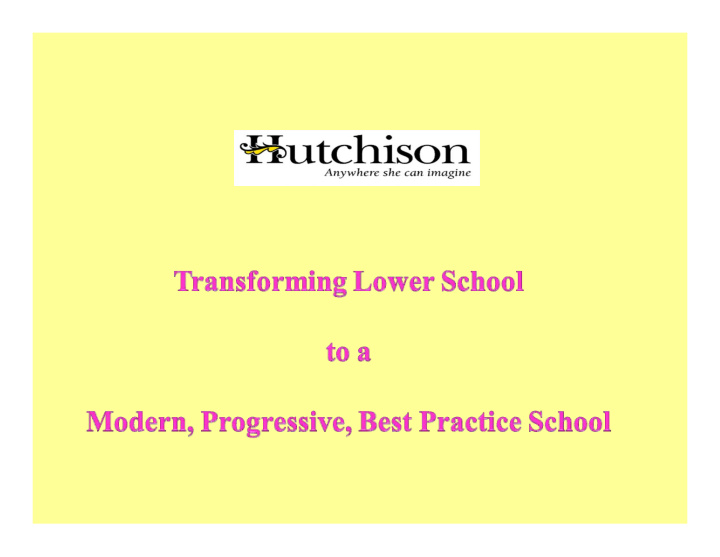



WHAT DID THE DATA SAY? � JK – 8 MATH PROGRAM � PREK–12 WORLD LANGUAGE PROGRAM � PREK – 6 LITERACY PROGRAM
ROLE OF STAKEHOLDERS
Board of Trustees $$$$$ � Master Teacher Program � Professional development Commitment to change
Head of School & Division Leadership � Vision and experience � Decision making criteria Parents � Buy in and support
Faculty
Professional Development Best Practices Types of PD: PD tied to: � Road trips � Strategic goals � Task Forces � Best practices � Visiting Scholars � Summer Reading � Summer grants
Teacher’s Observations � Workbooks, Workbooks, Workbooks � Dabbling at Whole Language instruction � Where is the differentiation?
The Need for Change…ERB Reports � Math sc o re s highe r than re ading sc o re s � Audito ry and re ading c o mpre he nsio n gaps
Division Head Observations � Do n’t c hange during the first ye ar. Re ally? � T he sno wball is ge tting large r…
Professional Development = Consultants & Literacy Scholars � Heinemann comprehension and reading assessment consultants � Intermediate and middle school literacy consultant � Faculty buy in of consultants: Why? � Pacing and plan for consultant visits
Professional Reading � Making the Most of Small Groups � Mosaic of Thought Debbie Diller Keene and Zimmerman � Strategies That Work � 6 + 1 Traits of Writing Harvery Ruth Culham � Best Practices � The Fluent Reader Zemelman, Daniels, & Hyde Rasinski � A Guide to Benchmark Assessment System � A Whole New Mind Fountas & Pinnell Daniel Pink � The Continuum of Literacy Learning � Apprenticeship in Literacy Fountas & Pinnell Dorn, French, & Jones
Faculty Teams � Consideration of Strengths and Placement � Safe Supported Opportunity to Learn � Time to Learn on the Job � Input from Faculty
Integration & Differentiation � Why Integrate? � Time � Authenticity � More comprehensive � Differentiate? � Small Groups � Individualized assessment
Assessment/Reporting Formative Assessment � Developing writing rubrics to correlate with WRAP Implementing running record assessment in reading using F&P and DRA � Utilizing EDM assessment with math boxes and open response � � Anecdotal notes
Summative Assessment � T eac hing with the end in mind by develo ping a standards based repo rt c ard � I dentifying and aligning standards in literac y, math, so c ial studies, and sc ienc e � Develo ping quarterly expec tatio ns and assigning benc hmarks
Report Cards � New format identifying key standards in content areas � New format identifying benchmark expectations by quarter instead of grades � Transitioning from grades to benchmark assignment: S ecure, D eveloping, B elow, N eeds Improvement � Parent education
Assessment + Reporting = Change in Instruction � Fewer worksheets � More small group work � More differentiated groups � More independent differentiation � More leveled reading instruction
More opportunity for • independent goals More opportunity for Higher ERB scores • project learning More creative, authentic, • and integrative instruction More reading/writing • workshop instruction
Where are we now? � Our Mantra: What is good for the girls? � We continue to “Tweak”. � More Professional Development
Professional Development � Phonics refinement 1 st /2 nd � EDM Resident Experts � Literacy Lab 3 rd /4 th � Creativity is a Priority � Closing divisional gaps � Creating Faculty Leadership � Literacy Specialist for Classrooms � Technology Integration
BALLET ENGINEERING GYMNASTICS TIGHT ROPE WALKING SKATING ARCHITECTURE First Grade: BALANCING & WEIGHING
E xplor ing & De signing
Based on a true story of a boy who wanted to fly his kite across the Niagra River to help build a bridge. He succeeded in landing it from the Canadian side to the American side. Soon after, the first suspension bridge was built across the great Niagra Gorge.
F ilmmaking: shor ts Reading Geography Science Listening Technology Speaking Imaginative Thinking Writing
The Invention of Hugo Cabret by Brian Selznick
Content Study: 1 st Half � Silent films by Georges Melies, Charlie Chaplin, Edison and Lumiere Brothers � Pixar shorts and other shorts on YouTube � Jacob Burns Film Institute’s kids videos � Lincoln Center Institute
Eberle’ ’s Strategy: s Strategy: Eberle SCAMPER SCAMPER s ubstitute s c ombine c a dapt a m aximize m p ut to good use p e laborate e r earrange r
Key Ideas Key Ideas Building Vocabulary � analyzing plot with storyboarding � imaginative thinking skills: brainstorming, noticing deeply, adapting, asking questions, identifying patterns, making connections, reflecting � collaborative problem-solving skills � technology � creating a short film with criteria
VIQ: Questions? Can integration be relevant to the present lives of the students? Do the activities ignite the students’ imaginative thinking and awareness to their imagination and others’ thinking? Can teachers access the school’s curriculum with the selected focus? Is support for the multi-disciplined process?
Production Production
Language Arts Technology
Criteria List � Main idea � Clear message � Two or more characters � Chase scene � Three or more locations � Beginning, middle and end
Now… Where Are We Heading? � Innovation/Creativity Task Force � Reggio-inspired Early Childhood Program � STEM initiatives � K-12 Conversations by Curriculum Teams � Teacher-leader resident experts � Hutchison LEADS � Integration.. integration .. integration
Feel free to contact us… Laurie Stanton Assistant Head for Program lstanton@hutchisonschool.org Noel Brewster Lower School Head nbrewster@hutchisonschool.org Susan Hale 1 st Grade Teacher shale@hutchisonschool.org Cathleen Sibley 3 rd Grade Teacher csibley@hutchisonschool.org
Recommend
More recommend